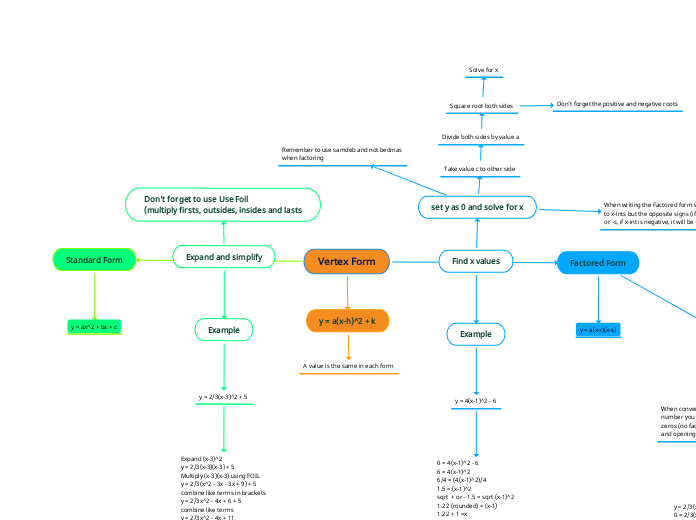Vertex Form
y = a(x-h)^2 + k
A value is the same in each form
Factored Form
y = a(x-r)(x-s)
Special occasions
When converting from Vertex form to factored form, if the number you are square rooting is negative, then there are no zeros (no factored form). The vertex is either above the x-axis and opening upwards, or it is below and opening downwards.
Example
y = 2/3(x-3)^2 + 5
0 = 2/3(x-3)^2 + 5
-5 = 2/3(x-3)^2
(-5)/(2/3) = (2/3(x-3)^2)/(2/3)
-7.5 = (x-3)^2
cannot square root -7.5, therefore there are no zeros
Standard Form
y = ax^2 + bx + c
Expand and simplify
Don't forget to use Use Foil
(multiply firsts, outsides, insides and lasts
Example
y = 2/3(x-3)^2 + 5
Expand (x-3)^2
y = 2/3(x-3)(x-3) + 5
Multiply (x-3)(x-3) using FOIL
y = 2/3(x^2 - 3x - 3x + 9) + 5
combine like terms in brackets
y = 2/3x^2 - 4x + 6 + 5
combine like terms
y = 2/3x^2 - 4x + 11
Find x values
set y as 0 and solve for x
Take value c to other side
Divide both sides by value a
Square root both sides
Solve for x
Don't forget the positive and negative roots
When writing the Factored form with the x-int, r and s are equal to x-ints but the opposite signs (if the x-int is positive,it will be -r or -s, if x-int is negative, it will be +r or +s)
Remember to use samdeb and not bedmas
when factoring
Example
y = 4(x-1)^2 - 6
0 = 4(x-1)^2 - 6
6 = 4(x-1)^2
6/4 = (4(x-1)^2)/4
1.5 = (x-1)^2
sqrt + or - 1.5 = sqrt (x-1)^2
1.22 (rounded) = (x-1)
1.22 + 1 =x
x = 2.22
-1.22 = (x-1)
-1.22 + 1 = x
x = -0.22
x ints are = 2.22 and -0.22
y = 4(x-2.22)(x+0.22)
